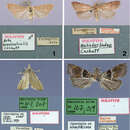Penthesilea (moth): Brief Summary
provided by wikipedia EN
Penthesilea is a genus of moths in the family Pyralidae.
- license
- cc-by-sa-3.0
- copyright
- Wikipedia authors and editors
Description
provided by Zookeys
Head. Labial palpus decumbent; length of male palpus nearly equal to head width, length of female palpus longer than head width; maxillary palpus vestigial; proboscis moderately well-developed; frons rounded with vestiture extended obliquely; vertex smooth-scaled; occiput rough-scaled; eye large; ocellus separated from base of antenna by scales; without a chaetosema.
Thorax. Forewing broad and arched at base, apex broadly rounded, outer margin and anal angle broadly rounded; sexually dimorphic; male with a tympanic vesicle at base of costa, with a large hair-pencil gland as in Salobrena; female without a glandular vesicle; both sexes with Sc long, intercepting costa past one-half length; R1 and R2 separate; R3 and R4 stalked, R5 from stem; M1 from end of discal cell just below anterior angle; M2 and M3 separate and arising from posterior angle of discal cell; Cu1 and Cu2 separate and arising from below posterior angle of cell; 1A absent, 2A and 3A separate at base but briefly anastomosed a short distance distad; retinaculum of male loop-shaped and strongly developed with inner surface corrugated as in Salobrena, Clydonopteron, Satole and Tosale. Hind wing of male with frenulum stoutly developed with a short hook at base, female normal; Sc arched at base and anastomosed with Rs past end of discal cell; M1 arising from anterior angle of discal cell; M2 and M3 separate, arising from the posterior angle of discal cell; Cu1 and Cu2 separate, from before the posterior angle of the discal cell. Legs with scale tufts on mid and hind tibia.
Abdomen. Short and stout; male with a small lateral pleurite on the terminal segment bearing a tuft of scales as in Tosale and Salobrena.
Male genitalia. Uncus narrow, dorsally setose, aculeate with apex rounded, base with arms produced for articulation with gnathos, tips broadly rounded; vinculum narrow, saccus not produced anteriad; gnathos apex aculeate, gently curved dorsad, arms gradually expanded to broad articulation with modified pedunculus and base of uncus; valva narrow, tips directed slightly upward and mediad, sacculus without a clasping process; transtilla moderately developed and incomplete; juxta trapezoidal, dorsal margin concave; phallus slightly curved upward, proximal end slightly expanded, coecum small, without a cornutus.
Female genitalia. Ovipositor moderately short, apex of papillae anales unilobate; anterior apophysis slightly longer than posterior apophysis; lamella postvaginalis triangulate; anterior margin of eighth tergite rounded; ostium bursae membranous; a sclerotized constriction below antrum on ductus seminalis as in Tosale; inception of ductus seminalis at junction of ductus bursae and corpus bursae; corpus bursae without a signum.
- license
- cc-by-3.0
- copyright
- M. Alma Solis, Everett D. Cashatt, Brian G. Scholtens
- bibliographic citation
- Solis M, Cashatt E, Scholtens B (2013) New North American Chrysauginae (Pyralidae) described by E.D. Cashatt ZooKeys 344: 55–71
- author
- M. Alma Solis
- author
- Everett D. Cashatt
- author
- Brian G. Scholtens

